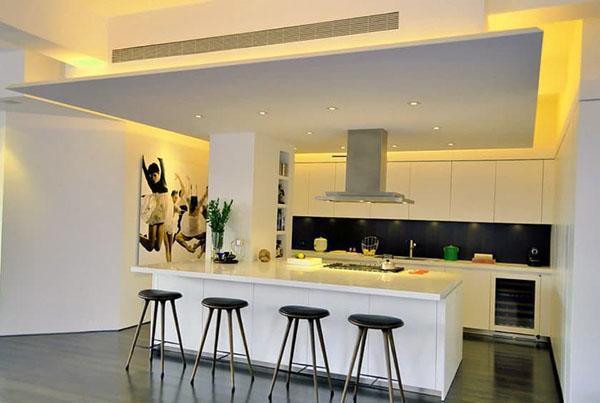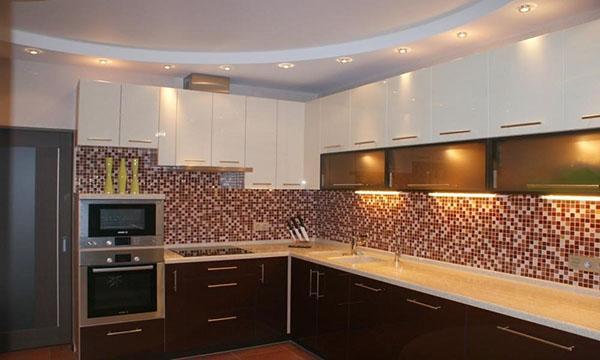What material to finish the ceiling in the kitchen

By planning update the ceiling in the kitchen, you need to remember that it plays a significant role in general the interior of this room. Considering the extreme loads to which its surface, the selection of options and materials should be considered very demanding, starting from the practicality of each of them.
Requirements to kitchen ceilings

This room is intended for cooking, which is associated with fatty fumes and a lot of heat. In addition, the surface of the ceiling is often exposed to detergents and splashes of water. When the room is ventilated, condensation forms, followed by freezing.
Therefore, choosing a practical kitchen ceiling should be based on the following characteristics:
- waterproofness;
- resistance to the use of detergents;
- surface durability that can withstand repeated cleaning;
- presentable view;
- safety and environmental friendliness;
- long-term operation.
Not worth it choose the most budgetary finishing option, it is better to give preference to reliable and proven kitchen ceilings. The right choice and the efforts made will help create a surface capable of to please the owners.
Material selection
Modern materials for the kitchen ceiling are represented by a huge assortment: rack or tension structures, panel, wallpaper or painted. The classic option is perfect plastering, followed by painting. This results in a smooth white surface that perfectly refreshes the room.
Plaster is an environmentally natural material, and white color visually enlarges the space, which is necessary for small-sized rooms.
When deciding what is better to make the ceiling in the kitchen, they give preference to materials that cannot adversely affect aesthetics and functionality:
- plasterboard ceiling;
- surface painting;
- ceiling tiles;
- pasting with wallpaper;
- tension structure;
- plastic panels.
By choosing any of the options, you need to familiarize yourself with its characteristics, and positive and negative sides.
Plasterboard ceiling in the kitchen

Drywall refers to a material that allows you to qualitatively hide irregularities or defects, and hide engineering communications under it. There are many different ideas and solutions for using it. False ceilings in the kitchen make it easier to place original lamps built-in type, decorating the room and increasing the visual verticality of the walls.
The advantages of plasterboard ceilings include:
- the ability to hide floor defects;
- do not require additional finishing;
- allow you to create various lighting options;
- long period of operation;
- strength to shock and other mechanical stress;
- improved heat and sound insulation;
- design variability;
- low cost.
When choosing a material for kitchen ceilings, you should focus on moisture-resistant drywall sheets, which are easier to wash and do not change their color from moisture.
Plastic panels

Solving the question of what to make the ceiling in a kitchen suffering from insufficient ventilation, the best option is hard to find. This is the cheapest option for ceiling decoration, is the most durable and practical.This material responds well to wet cleaning, and requires a minimum amount of time for care. Installation panels can be performed even by beginners with no construction experience.
Thanks to the rich choice of color solutions, the room can be given any desired style. With sufficient height, you can create multi-level ceilings in the kitchen, which will require no more than 10 cm.
The advantages of this option include:
- plastic ceilings successfully survive flooding;
- the material is easy to clean;
- if the lamellas are damaged, they can be easily replaced;
- hanging structure allows you to hide electrical wiring and other engineering communications;
- no need to level the base before installation;
- one-piece construction, practically without gaps;
- affordable price.
Diversity colors allows you to build a suspended ceiling in the kitchen corresponding to the general the interior.
Stretched PVC ceilings

The most popular option among modern finishes. This design simultaneously solves several problems:
- does not require foundation preparation;
- hides all kinds of communications;
- excellent moisture resistance, allowing to withstand about 100 liters per square meter of canvas;
- the service life, with proper handling, reaches 20 years;
- high degree of fire safety;
- variability of lighting;
- firmly tolerate temperature changes inherent in the atmosphere of the room;
- quick installation with minimal room pollution.
Such a ceiling in the kitchen it can be glossy or matte, and suits any style.
The glossy surface is capable of reflecting objects, creating a sense of disorder and variegation. This makes the ceiling visually much lower than it actually is.
Coloration

In search of an inexpensive solution, you can stop at this option. Externally, the surface will resemble a bleached one, but it will be durable and practical. This type of finishing of ceilings in the kitchen can be done in any color, choosing a shade that matches the interior and style.
The advantages of painting include:
- such ceilings can be washed, they tolerate moisture well;
- low cost of materials;
- the ability to independently perform work;
- not frequent need for updating.
Disadvantage such a finish is paint cracking and peeling after leaks and expiration of time. This excludes the possibility of local repairs, the paint will have to be removed completely, the surface should be re-putty and painted. For to prevent such troubles, you should choose a moisture-resistant paint, with anti-fungal properties. The best option would be those that designed specifically for ceiling surfaces in bathrooms and kitchens premises. Applying pretty patterns using stencils allows get a practical alternative to wallpaper.
Wallpaper decoration

If, when solving the problem of how to make a ceiling in the kitchen, you have chosen wallpaper, this is not the worst finishing option. Modern manufacturers offer a huge selection of roll materials that differ in texture and resistance to extreme factors. When choosing, it should be remembered that the volumetric structure of the front part provokes the accumulation of fatty deposits, which are difficult to get rid of. Better to give preference non-woven wallpaperresistant to chemicals and moisture.
The advantages of this option include:
- suits any wallet - finishing can be economical or expensive exclusive;
- unlimited design choices;
- go well with tiles to the ceiling in the kitchen;
- do not require the use of expensive tools when gluing;
- easy local repairs;
- Wallpaper intended for painting can be repainted many times.
Considering the specifics of the kitchen, the wallpaper for it should be moisture-resistant or washable.If the ceilings are affected by mold, it is recommended to use glass fiber, non-woven or vinyl roll material.
Original registration

Sheathing with planks, ceiling panels or wood clapboard gives a cozy feeling to any interior.



However, in a small, low room, it is recommended to dosed use of this material, making small transitions from ceiling to walls to highlight a specific area.


If height permits, bleached or painted ceilings can be decorated with moldings or chic stucco. This will allow you to separate the dining area, focus on a chic chandelier and add solemnity to the entire interior.


To determine the choice of option, you should compare material opportunities with aesthetic demands. This will help you select materials that have the best performance.

Look for your own option among the ocean of incredible ideas, among which there will definitely be a successful solution for you.